This article is based on source code learning of Kubernetes v1.22.4 version
12. Implementation of Admission mechanism
1) Introduction to Admission
Admission Controller is executed after the HTTP request has been logged in and authenticated and before the Request is actually processed and stored in Etcd. It can modify the request object (Mutation) or verify the request (Validation).

After a Request enters the API Server, it will go through the following processing:
- Authentication Authorization : Login and authentication, verify whether the Request sender is legitimate
- Decode & Conversion : Request is sent in JSON format, converted to Go structure type, and the external version is converted into API Server internal APIObject version
- Admission-Mutation : Get the Request and adjust the content
- Admission - Mutation Webhook : Call the Mutation logic of Kubernetes user extension through Webhook
- Admission - Validation : Get the Request to verify the content
- Admission - Validation Webhook : Call the Validation logic of Kubernetes user extension through Webhook
- ETCD : Implement the Request into ETCD
2), built-in Admission Plugin
When starting the API Server, some Admissions are enabled by default. Users can enable or disable specified Admissions through startup parameters, but they cannot affect the internal logic of an Admission.
// pkg/kubeapiserver/options/plugins.go
var AllOrderedPlugins = []string{
admit.PluginName, // AlwaysAdmit
autoprovision.PluginName, // NamespaceAutoProvision
lifecycle.PluginName, // NamespaceLifecycle
exists.PluginName, // NamespaceExists
scdeny.PluginName, // SecurityContextDeny
antiaffinity.PluginName, // LimitPodHardAntiAffinityTopology
limitranger.PluginName, // LimitRanger
serviceaccount.PluginName, // ServiceAccount
noderestriction.PluginName, // NodeRestriction
nodetaint.PluginName, // TaintNodesByCondition
alwayspullimages.PluginName, // AlwaysPullImages
imagepolicy.PluginName, // ImagePolicyWebhook
podsecuritypolicy.PluginName, // PodSecurityPolicy
podsecurity.PluginName, // PodSecurity
podnodeselector.PluginName, // PodNodeSelector
podpriority.PluginName, // Priority
defaulttolerationseconds.PluginName, // DefaultTolerationSeconds
podtolerationrestriction.PluginName, // PodTolerationRestriction
eventratelimit.PluginName, // EventRateLimit
extendedresourcetoleration.PluginName, // ExtendedResourceToleration
label.PluginName, // PersistentVolumeLabel
setdefault.PluginName, // DefaultStorageClass
storageobjectinuseprotection.PluginName, // StorageObjectInUseProtection
gc.PluginName, // OwnerReferencesPermissionEnforcement
resize.PluginName, // PersistentVolumeClaimResize
runtimeclass.PluginName, // RuntimeClass
certapproval.PluginName, // CertificateApproval
certsigning.PluginName, // CertificateSigning
certsubjectrestriction.PluginName, // CertificateSubjectRestriction
defaultingressclass.PluginName, // DefaultIngressClass
denyserviceexternalips.PluginName, // DenyServiceExternalIPs
// new admission plugins should generally be inserted above here
// webhook, resourcequota, and deny plugins must go at the end
mutatingwebhook.PluginName, // MutatingAdmissionWebhook
validatingwebhook.PluginName, // ValidatingAdmissionWebhook
resourcequota.PluginName, // ResourceQuota
deny.PluginName, // AlwaysDeny
}
There are three special Admission Plugins: ImagePolicyWebhook, MutatingAdmissionWebhook, and ValidatingAdmissionWebhook. They will call the Web service written by the user according to the settings, pass in the target Object of the request, and let the service determine whether it needs to be rejected, allowed, or modified. This is one of the standard extension methods provided by Kubernetes
3) Assembly of Admission Plugin
1) Load Admission Option
The calling logic between functions is as follows:
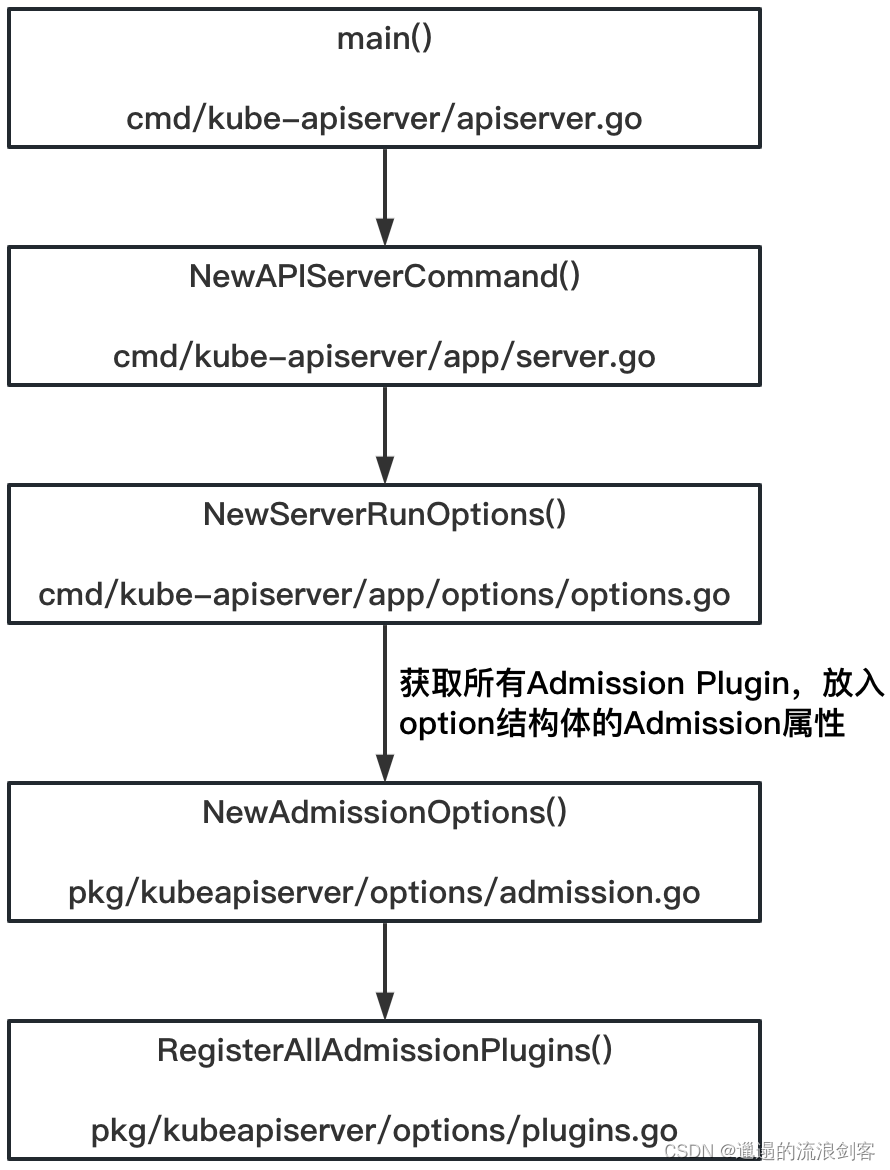
The core is RegisterAllAdmissionPlugins()the method, the code is as follows:
// pkg/kubeapiserver/options/plugins.go
func RegisterAllAdmissionPlugins(plugins *admission.Plugins) {
// 把所有的Admission Plugin都拿出来,通过传入的参数plugins带出去,最后被交到option的Admission属性上
admit.Register(plugins) // DEPRECATED as no real meaning
alwayspullimages.Register(plugins)
antiaffinity.Register(plugins)
defaulttolerationseconds.Register(plugins)
defaultingressclass.Register(plugins)
denyserviceexternalips.Register(plugins)
deny.Register(plugins) // DEPRECATED as no real meaning
eventratelimit.Register(plugins)
extendedresourcetoleration.Register(plugins)
gc.Register(plugins)
imagepolicy.Register(plugins)
limitranger.Register(plugins)
autoprovision.Register(plugins)
exists.Register(plugins)
noderestriction.Register(plugins)
nodetaint.Register(plugins)
label.Register(plugins) // DEPRECATED, future PVs should not rely on labels for zone topology
podnodeselector.Register(plugins)
podtolerationrestriction.Register(plugins)
runtimeclass.Register(plugins)
resourcequota.Register(plugins)
podsecurity.Register(plugins) // before PodSecurityPolicy so audit/warn get exercised even if PodSecurityPolicy denies
podsecuritypolicy.Register(plugins)
podpriority.Register(plugins)
scdeny.Register(plugins)
serviceaccount.Register(plugins)
setdefault.Register(plugins)
resize.Register(plugins)
storageobjectinuseprotection.Register(plugins)
certapproval.Register(plugins)
certsigning.Register(plugins)
certsubjectrestriction.Register(plugins)
}
2) Configure APIServer Config according to Admission Option
The calling logic between functions is as follows:
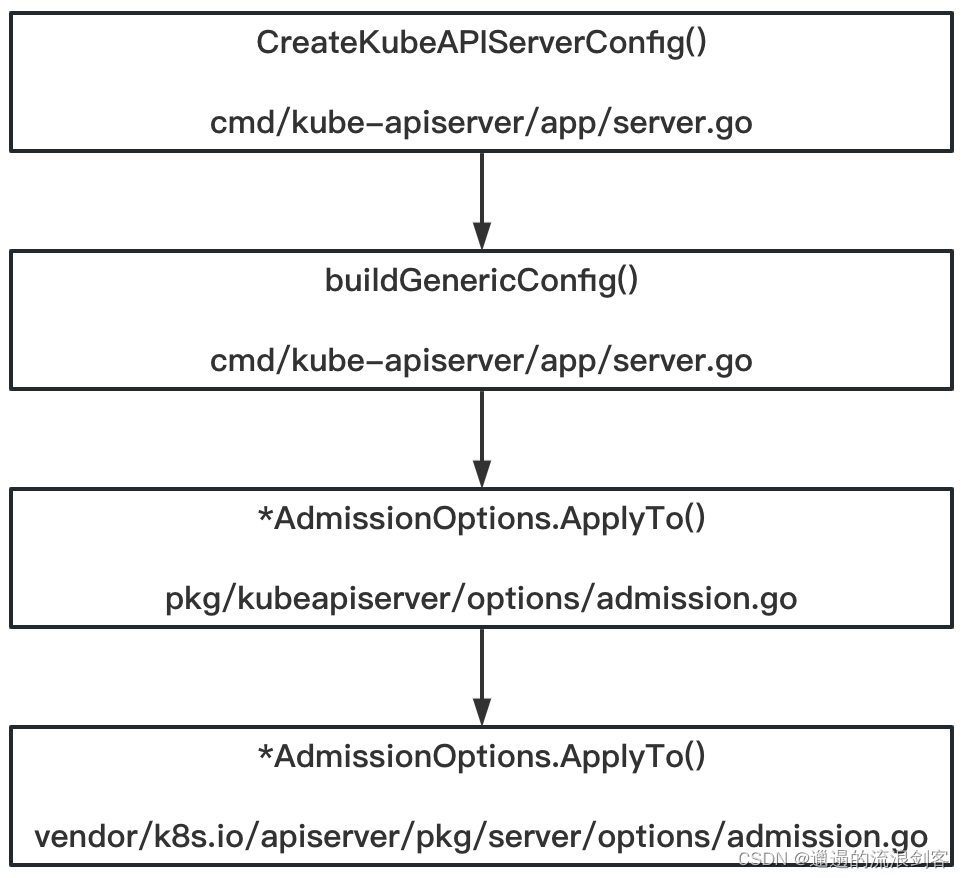
The core is ApplyTo()the method, the code is as follows:
// vendor/k8s.io/apiserver/pkg/server/options/admission.go
func (a *AdmissionOptions) ApplyTo(
c *server.Config,
informers informers.SharedInformerFactory,
kubeAPIServerClientConfig *rest.Config,
features featuregate.FeatureGate,
pluginInitializers ...admission.PluginInitializer,
) error {
if a == nil {
return nil
}
// Admission depends on CoreAPI to set SharedInformerFactory and ClientConfig.
if informers == nil {
return fmt.Errorf("admission depends on a Kubernetes core API shared informer, it cannot be nil")
}
pluginNames := a.enabledPluginNames()
pluginsConfigProvider, err := admission.ReadAdmissionConfiguration(pluginNames, a.ConfigFile, configScheme)
if err != nil {
return fmt.Errorf("failed to read plugin config: %v", err)
}
clientset, err := kubernetes.NewForConfig(kubeAPIServerClientConfig)
if err != nil {
return err
}
genericInitializer := initializer.New(clientset, informers, c.Authorization.Authorizer, features)
initializersChain := admission.PluginInitializers{
}
pluginInitializers = append(pluginInitializers, genericInitializer)
initializersChain = append(initializersChain, pluginInitializers...)
// 启用的Admission Plugin生成admissionChain
admissionChain, err := a.Plugins.NewFromPlugins(pluginNames, pluginsConfigProvider, initializersChain, a.Decorators)
if err != nil {
return err
}
// 将admissionChain被放入server.Config的AdmissionControl属性
c.AdmissionControl = admissionmetrics.WithStepMetrics(admissionChain)
return nil
}
3) Admission Plugin is injected into the Request Handler
The logic related to Admission in the API Resource loading process is as follows:

Taking the PUT request as an example, registerResourceHandlers()the calling logic in the method is as follows:
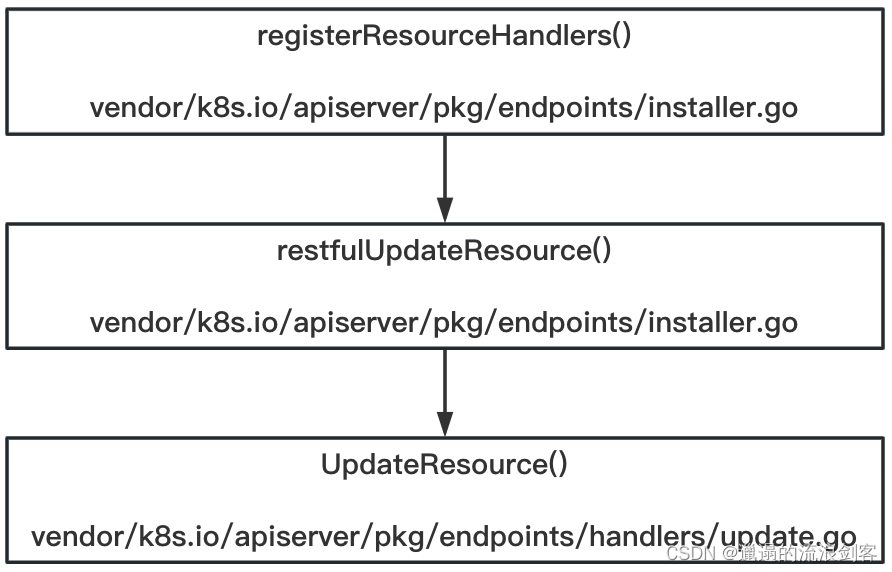
vendor/k8s.io/apiserver/pkg/endpoints/handlersEach file under the package corresponds to an http verb, which is responsible for building the handler for the verb.

UpdateResource()The method code is as follows:
// vendor/k8s.io/apiserver/pkg/endpoints/handlers/update.go
// admit为其输入参数
func UpdateResource(r rest.Updater, scope *RequestScope, admit admission.Interface) http.HandlerFunc {
return func(w http.ResponseWriter, req *http.Request) {
// For performance tracking purposes.
trace := utiltrace.New("Update", traceFields(req)...)
defer trace.LogIfLong(500 * time.Millisecond)
if isDryRun(req.URL) && !utilfeature.DefaultFeatureGate.Enabled(features.DryRun) {
scope.err(errors.NewBadRequest("the dryRun feature is disabled"), w, req)
return
}
namespace, name, err := scope.Namer.Name(req)
if err != nil {
scope.err(err, w, req)
return
}
// enforce a timeout of at most requestTimeoutUpperBound (34s) or less if the user-provided
// timeout inside the parent context is lower than requestTimeoutUpperBound.
ctx, cancel := context.WithTimeout(req.Context(), requestTimeoutUpperBound)
defer cancel()
ctx = request.WithNamespace(ctx, namespace)
outputMediaType, _, err := negotiation.NegotiateOutputMediaType(req, scope.Serializer, scope)
if err != nil {
scope.err(err, w, req)
return
}
body, err := limitedReadBody(req, scope.MaxRequestBodyBytes)
if err != nil {
scope.err(err, w, req)
return
}
options := &metav1.UpdateOptions{
}
if err := metainternalversionscheme.ParameterCodec.DecodeParameters(req.URL.Query(), scope.MetaGroupVersion, options); err != nil {
err = errors.NewBadRequest(err.Error())
scope.err(err, w, req)
return
}
if errs := validation.ValidateUpdateOptions(options); len(errs) > 0 {
err := errors.NewInvalid(schema.GroupKind{
Group: metav1.GroupName, Kind: "UpdateOptions"}, "", errs)
scope.err(err, w, req)
return
}
options.TypeMeta.SetGroupVersionKind(metav1.SchemeGroupVersion.WithKind("UpdateOptions"))
s, err := negotiation.NegotiateInputSerializer(req, false, scope.Serializer)
if err != nil {
scope.err(err, w, req)
return
}
defaultGVK := scope.Kind
original := r.New()
trace.Step("About to convert to expected version")
decoder := scope.Serializer.DecoderToVersion(s.Serializer, scope.HubGroupVersion)
obj, gvk, err := decoder.Decode(body, &defaultGVK, original)
if err != nil {
err = transformDecodeError(scope.Typer, err, original, gvk, body)
scope.err(err, w, req)
return
}
objGV := gvk.GroupVersion()
if !scope.AcceptsGroupVersion(objGV) {
err = errors.NewBadRequest(fmt.Sprintf("the API version in the data (%s) does not match the expected API version (%s)", objGV, defaultGVK.GroupVersion()))
scope.err(err, w, req)
return
}
trace.Step("Conversion done")
ae := request.AuditEventFrom(ctx)
audit.LogRequestObject(ae, obj, objGV, scope.Resource, scope.Subresource, scope.Serializer)
admit = admission.WithAudit(admit, ae)
if err := checkName(obj, name, namespace, scope.Namer); err != nil {
scope.err(err, w, req)
return
}
userInfo, _ := request.UserFrom(ctx)
transformers := []rest.TransformFunc{
}
// allows skipping managedFields update if the resulting object is too big
shouldUpdateManagedFields := true
if scope.FieldManager != nil {
admit = fieldmanager.NewManagedFieldsValidatingAdmissionController(admit)
transformers = append(transformers, func(_ context.Context, newObj, liveObj runtime.Object) (runtime.Object, error) {
if shouldUpdateManagedFields {
return scope.FieldManager.UpdateNoErrors(liveObj, newObj, managerOrUserAgent(options.FieldManager, req.UserAgent())), nil
}
return newObj, nil
})
}
// 1)用mutation admission来构造Transformer,用于更改被更新的目标Object
if mutatingAdmission, ok := admit.(admission.MutationInterface); ok {
transformers = append(transformers, func(ctx context.Context, newObj, oldObj runtime.Object) (runtime.Object, error) {
isNotZeroObject, err := hasUID(oldObj)
if err != nil {
return nil, fmt.Errorf("unexpected error when extracting UID from oldObj: %v", err.Error())
} else if !isNotZeroObject {
if mutatingAdmission.Handles(admission.Create) {
return newObj, mutatingAdmission.Admit(ctx, admission.NewAttributesRecord(newObj, nil, scope.Kind, namespace, name, scope.Resource, scope.Subresource, admission.Create, updateToCreateOptions(options), dryrun.IsDryRun(options.DryRun), userInfo), scope)
}
} else {
if mutatingAdmission.Handles(admission.Update) {
return newObj, mutatingAdmission.Admit(ctx, admission.NewAttributesRecord(newObj, oldObj, scope.Kind, namespace, name, scope.Resource, scope.Subresource, admission.Update, options, dryrun.IsDryRun(options.DryRun), userInfo), scope)
}
}
return newObj, nil
})
transformers = append(transformers, func(ctx context.Context, newObj, oldObj runtime.Object) (runtime.Object, error) {
// Dedup owner references again after mutating admission happens
dedupOwnerReferencesAndAddWarning(newObj, req.Context(), true)
return newObj, nil
})
}
createAuthorizerAttributes := authorizer.AttributesRecord{
User: userInfo,
ResourceRequest: true,
Path: req.URL.Path,
Verb: "create",
APIGroup: scope.Resource.Group,
APIVersion: scope.Resource.Version,
Resource: scope.Resource.Resource,
Subresource: scope.Subresource,
Namespace: namespace,
Name: name,
}
trace.Step("About to store object in database")
wasCreated := false
// 2)调用r.Update()方法
requestFunc := func() (runtime.Object, error) {
obj, created, err := r.Update(
ctx,
name,
rest.DefaultUpdatedObjectInfo(obj, transformers...),
withAuthorization(rest.AdmissionToValidateObjectFunc(
admit,
admission.NewAttributesRecord(nil, nil, scope.Kind, namespace, name, scope.Resource, scope.Subresource, admission.Create, updateToCreateOptions(options), dryrun.IsDryRun(options.DryRun), userInfo), scope),
scope.Authorizer, createAuthorizerAttributes),
rest.AdmissionToValidateObjectUpdateFunc(
admit,
admission.NewAttributesRecord(nil, nil, scope.Kind, namespace, name, scope.Resource, scope.Subresource, admission.Update, options, dryrun.IsDryRun(options.DryRun), userInfo), scope),
false,
options,
)
wasCreated = created
return obj, err
}
// Dedup owner references before updating managed fields
dedupOwnerReferencesAndAddWarning(obj, req.Context(), false)
result, err := finisher.FinishRequest(ctx, func() (runtime.Object, error) {
result, err := requestFunc()
// If the object wasn't committed to storage because it's serialized size was too large,
// it is safe to remove managedFields (which can be large) and try again.
if isTooLargeError(err) && scope.FieldManager != nil {
if accessor, accessorErr := meta.Accessor(obj); accessorErr == nil {
accessor.SetManagedFields(nil)
shouldUpdateManagedFields = false
result, err = requestFunc()
}
}
return result, err
})
if err != nil {
scope.err(err, w, req)
return
}
trace.Step("Object stored in database")
status := http.StatusOK
if wasCreated {
status = http.StatusCreated
}
transformResponseObject(ctx, scope, trace, req, w, status, outputMediaType, result)
}
}
UpdateResource()Mutation Admission is used in the method to construct a Transformer, which is used to change the updated target Object, and then calls r.Update()the method. The method is implemented as follows:
// vendor/k8s.io/apiserver/pkg/registry/generic/registry/store.go
func (e *Store) Update(ctx context.Context, name string, objInfo rest.UpdatedObjectInfo, createValidation rest.ValidateObjectFunc, updateValidation rest.ValidateObjectUpdateFunc, forceAllowCreate bool, options *metav1.UpdateOptions) (runtime.Object, bool, error) {
key, err := e.KeyFunc(ctx, name)
if err != nil {
return nil, false, err
}
var (
creatingObj runtime.Object
creating = false
)
qualifiedResource := e.qualifiedResourceFromContext(ctx)
storagePreconditions := &storage.Preconditions{
}
if preconditions := objInfo.Preconditions(); preconditions != nil {
storagePreconditions.UID = preconditions.UID
storagePreconditions.ResourceVersion = preconditions.ResourceVersion
}
out := e.NewFunc()
// deleteObj is only used in case a deletion is carried out
var deleteObj runtime.Object
err = e.Storage.GuaranteedUpdate(ctx, key, out, true, storagePreconditions, func(existing runtime.Object, res storage.ResponseMeta) (runtime.Object, *uint64, error) {
existingResourceVersion, err := e.Storage.Versioner().ObjectResourceVersion(existing)
if err != nil {
return nil, nil, err
}
if existingResourceVersion == 0 {
if !e.UpdateStrategy.AllowCreateOnUpdate() && !forceAllowCreate {
return nil, nil, apierrors.NewNotFound(qualifiedResource, name)
}
}
// 1)调用transformers,完成mutation Admission
// Given the existing object, get the new object
obj, err := objInfo.UpdatedObject(ctx, existing)
if err != nil {
return nil, nil, err
}
// If AllowUnconditionalUpdate() is true and the object specified by
// the user does not have a resource version, then we populate it with
// the latest version. Else, we check that the version specified by
// the user matches the version of latest storage object.
newResourceVersion, err := e.Storage.Versioner().ObjectResourceVersion(obj)
if err != nil {
return nil, nil, err
}
doUnconditionalUpdate := newResourceVersion == 0 && e.UpdateStrategy.AllowUnconditionalUpdate()
if existingResourceVersion == 0 {
var finishCreate FinishFunc = finishNothing
if e.BeginCreate != nil {
fn, err := e.BeginCreate(ctx, obj, newCreateOptionsFromUpdateOptions(options))
if err != nil {
return nil, nil, err
}
finishCreate = fn
defer func() {
finishCreate(ctx, false)
}()
}
creating = true
creatingObj = obj
if err := rest.BeforeCreate(e.CreateStrategy, ctx, obj); err != nil {
return nil, nil, err
}
// at this point we have a fully formed object. It is time to call the validators that the apiserver
// handling chain wants to enforce.
if createValidation != nil {
if err := createValidation(ctx, obj.DeepCopyObject()); err != nil {
return nil, nil, err
}
}
ttl, err := e.calculateTTL(obj, 0, false)
if err != nil {
return nil, nil, err
}
// The operation has succeeded. Call the finish function if there is one,
// and then make sure the defer doesn't call it again.
fn := finishCreate
finishCreate = finishNothing
fn(ctx, true)
return obj, &ttl, nil
}
creating = false
creatingObj = nil
if doUnconditionalUpdate {
// Update the object's resource version to match the latest
// storage object's resource version.
err = e.Storage.Versioner().UpdateObject(obj, res.ResourceVersion)
if err != nil {
return nil, nil, err
}
} else {
// Check if the object's resource version matches the latest
// resource version.
if newResourceVersion == 0 {
// TODO: The Invalid error should have a field for Resource.
// After that field is added, we should fill the Resource and
// leave the Kind field empty. See the discussion in #18526.
qualifiedKind := schema.GroupKind{
Group: qualifiedResource.Group, Kind: qualifiedResource.Resource}
fieldErrList := field.ErrorList{
field.Invalid(field.NewPath("metadata").Child("resourceVersion"), newResourceVersion, "must be specified for an update")}
return nil, nil, apierrors.NewInvalid(qualifiedKind, name, fieldErrList)
}
if newResourceVersion != existingResourceVersion {
return nil, nil, apierrors.NewConflict(qualifiedResource, name, fmt.Errorf(OptimisticLockErrorMsg))
}
}
var finishUpdate FinishFunc = finishNothing
if e.BeginUpdate != nil {
fn, err := e.BeginUpdate(ctx, obj, existing, options)
if err != nil {
return nil, nil, err
}
finishUpdate = fn
defer func() {
finishUpdate(ctx, false)
}()
}
if err := rest.BeforeUpdate(e.UpdateStrategy, ctx, obj, existing); err != nil {
return nil, nil, err
}
// 2)使用validation Admission
// at this point we have a fully formed object. It is time to call the validators that the apiserver
// handling chain wants to enforce.
if updateValidation != nil {
if err := updateValidation(ctx, obj.DeepCopyObject(), existing.DeepCopyObject()); err != nil {
return nil, nil, err
}
}
// Check the default delete-during-update conditions, and store-specific conditions if provided
if ShouldDeleteDuringUpdate(ctx, key, obj, existing) &&
(e.ShouldDeleteDuringUpdate == nil || e.ShouldDeleteDuringUpdate(ctx, key, obj, existing)) {
deleteObj = obj
return nil, nil, errEmptiedFinalizers
}
ttl, err := e.calculateTTL(obj, res.TTL, true)
if err != nil {
return nil, nil, err
}
// The operation has succeeded. Call the finish function if there is one,
// and then make sure the defer doesn't call it again.
fn := finishUpdate
finishUpdate = finishNothing
fn(ctx, true)
if int64(ttl) != res.TTL {
return obj, &ttl, nil
}
return obj, nil, nil
}, dryrun.IsDryRun(options.DryRun), nil)
if err != nil {
// delete the object
if err == errEmptiedFinalizers {
return e.deleteWithoutFinalizers(ctx, name, key, deleteObj, storagePreconditions, newDeleteOptionsFromUpdateOptions(options))
}
if creating {
err = storeerr.InterpretCreateError(err, qualifiedResource, name)
err = rest.CheckGeneratedNameError(e.CreateStrategy, err, creatingObj)
} else {
err = storeerr.InterpretUpdateError(err, qualifiedResource, name)
}
return nil, false, err
}
if creating {
if e.AfterCreate != nil {
e.AfterCreate(out, newCreateOptionsFromUpdateOptions(options))
}
} else {
if e.AfterUpdate != nil {
e.AfterUpdate(out, options)
}
}
if e.Decorator != nil {
e.Decorator(out)
}
return out, creating, nil
}
Before the Update method of Storage Object, first call Transformers to complete the Mutation Admission, and then use the Validation Admission. If there is an error in the Validation, return directly.
13. HttpReq processing and Default Filters
1), Construction of RequestHandler

An HTTP request will be handled by an HttpHandler object, which has ServeHTTP()methods. Through the decorator mode, processing logic for different aspects is continuously wrapped around a Handler, thus forming the entire process of request and response.
The core methods in the assembly process of GenericAPIServer New()are as follows:
// vendor/k8s.io/apiserver/pkg/server/config.go
func (c completedConfig) New(name string, delegationTarget DelegationTarget) (*GenericAPIServer, error) {
if c.Serializer == nil {
return nil, fmt.Errorf("Genericapiserver.New() called with config.Serializer == nil")
}
if c.LoopbackClientConfig == nil {
return nil, fmt.Errorf("Genericapiserver.New() called with config.LoopbackClientConfig == nil")
}
if c.EquivalentResourceRegistry == nil {
return nil, fmt.Errorf("Genericapiserver.New() called with config.EquivalentResourceRegistry == nil")
}
// 构建handlerChain
// config.BuildHandlerChainFunc的实现为DefaultBuildHandlerChain方法
handlerChainBuilder := func(handler http.Handler) http.Handler {
return c.BuildHandlerChainFunc(handler, c.Config)
}
// 构建NewAPIServerHandler
apiServerHandler := NewAPIServerHandler(name, c.Serializer, handlerChainBuilder, delegationTarget.UnprotectedHandler())
// 实例化GenericAPIServer
s := &GenericAPIServer{
discoveryAddresses: c.DiscoveryAddresses,
LoopbackClientConfig: c.LoopbackClientConfig,
legacyAPIGroupPrefixes: c.LegacyAPIGroupPrefixes,
admissionControl: c.AdmissionControl,
Serializer: c.Serializer,
AuditBackend: c.AuditBackend,
Authorizer: c.Authorization.Authorizer,
delegationTarget: delegationTarget,
EquivalentResourceRegistry: c.EquivalentResourceRegistry,
HandlerChainWaitGroup: c.HandlerChainWaitGroup,
minRequestTimeout: time.Duration(c.MinRequestTimeout) * time.Second,
ShutdownTimeout: c.RequestTimeout,
ShutdownDelayDuration: c.ShutdownDelayDuration,
SecureServingInfo: c.SecureServing,
ExternalAddress: c.ExternalAddress,
// 构建了http request的路由,连接了url和响应函数;同时包含了一个request需要经过的预处理函数
Handler: apiServerHandler,
listedPathProvider: apiServerHandler,
openAPIConfig: c.OpenAPIConfig,
skipOpenAPIInstallation: c.SkipOpenAPIInstallation,
// 这些hook集合在New方法接下来的代码中填充,包含自己定义的和delegationTarget上的
postStartHooks: map[string]postStartHookEntry{
},
preShutdownHooks: map[string]preShutdownHookEntry{
},
disabledPostStartHooks: c.DisabledPostStartHooks,
healthzChecks: c.HealthzChecks,
livezChecks: c.LivezChecks,
readyzChecks: c.ReadyzChecks,
livezGracePeriod: c.LivezGracePeriod,
DiscoveryGroupManager: discovery.NewRootAPIsHandler(c.DiscoveryAddresses, c.Serializer),
maxRequestBodyBytes: c.MaxRequestBodyBytes,
livezClock: clock.RealClock{
},
lifecycleSignals: c.lifecycleSignals,
APIServerID: c.APIServerID,
StorageVersionManager: c.StorageVersionManager,
Version: c.Version,
}
for {
if c.JSONPatchMaxCopyBytes <= 0 {
break
}
existing := atomic.LoadInt64(&jsonpatch.AccumulatedCopySizeLimit)
if existing > 0 && existing < c.JSONPatchMaxCopyBytes {
break
}
if atomic.CompareAndSwapInt64(&jsonpatch.AccumulatedCopySizeLimit, existing, c.JSONPatchMaxCopyBytes) {
break
}
}
// 处理钩子hook操作
// first add poststarthooks from delegated targets
for k, v := range delegationTarget.PostStartHooks() {
s.postStartHooks[k] = v
}
for k, v := range delegationTarget.PreShutdownHooks() {
s.preShutdownHooks[k] = v
}
// add poststarthooks that were preconfigured. Using the add method will give us an error if the same name has already been registered.
for name, preconfiguredPostStartHook := range c.PostStartHooks {
if err := s.AddPostStartHook(name, preconfiguredPostStartHook.hook); err != nil {
return nil, err
}
}
genericApiServerHookName := "generic-apiserver-start-informers"
if c.SharedInformerFactory != nil {
if !s.isPostStartHookRegistered(genericApiServerHookName) {
err := s.AddPostStartHook(genericApiServerHookName, func(context PostStartHookContext) error {
c.SharedInformerFactory.Start(context.StopCh)
return nil
})
if err != nil {
return nil, err
}
}
// TODO: Once we get rid of /healthz consider changing this to post-start-hook.
err := s.AddReadyzChecks(healthz.NewInformerSyncHealthz(c.SharedInformerFactory))
if err != nil {
return nil, err
}
}
const priorityAndFairnessConfigConsumerHookName = "priority-and-fairness-config-consumer"
if s.isPostStartHookRegistered(priorityAndFairnessConfigConsumerHookName) {
} else if c.FlowControl != nil {
err := s.AddPostStartHook(priorityAndFairnessConfigConsumerHookName, func(context PostStartHookContext) error {
go c.FlowControl.MaintainObservations(context.StopCh)
go c.FlowControl.Run(context.StopCh)
return nil
})
if err != nil {
return nil, err
}
// TODO(yue9944882): plumb pre-shutdown-hook for request-management system?
} else {
klog.V(3).Infof("Not requested to run hook %s", priorityAndFairnessConfigConsumerHookName)
}
// Add PostStartHooks for maintaining the watermarks for the Priority-and-Fairness and the Max-in-Flight filters.
if c.FlowControl != nil {
const priorityAndFairnessFilterHookName = "priority-and-fairness-filter"
if !s.isPostStartHookRegistered(priorityAndFairnessFilterHookName) {
err := s.AddPostStartHook(priorityAndFairnessFilterHookName, func(context PostStartHookContext) error {
genericfilters.StartPriorityAndFairnessWatermarkMaintenance(context.StopCh)
return nil
})
if err != nil {
return nil, err
}
}
} else {
const maxInFlightFilterHookName = "max-in-flight-filter"
if !s.isPostStartHookRegistered(maxInFlightFilterHookName) {
err := s.AddPostStartHook(maxInFlightFilterHookName, func(context PostStartHookContext) error {
genericfilters.StartMaxInFlightWatermarkMaintenance(context.StopCh)
return nil
})
if err != nil {
return nil, err
}
}
}
for _, delegateCheck := range delegationTarget.HealthzChecks() {
skip := false
for _, existingCheck := range c.HealthzChecks {
if existingCheck.Name() == delegateCheck.Name() {
skip = true
break
}
}
if skip {
continue
}
s.AddHealthChecks(delegateCheck)
}
s.listedPathProvider = routes.ListedPathProviders{
s.listedPathProvider, delegationTarget}
// 安装API相关参数
installAPI(s, c.Config)
// use the UnprotectedHandler from the delegation target to ensure that we don't attempt to double authenticator, authorize,
// or some other part of the filter chain in delegation cases.
if delegationTarget.UnprotectedHandler() == nil && c.EnableIndex {
s.Handler.NonGoRestfulMux.NotFoundHandler(routes.IndexLister{
StatusCode: http.StatusNotFound,
PathProvider: s.listedPathProvider,
})
}
return s, nil
}
Build handlerChain in New()the method. handlerChainBuilder is an encapsulation of the CompleteHandlerChainFunc function of completedConfig. The default implementation is as follows:
// vendor/k8s.io/apiserver/pkg/server/config.go
// 通过装饰器模式包装apiHandler,包含认证、鉴权等一系列http filter chain,要先过这些http filter chain才访问到apiHandler
func DefaultBuildHandlerChain(apiHandler http.Handler, c *Config) http.Handler {
handler := filterlatency.TrackCompleted(apiHandler)
handler = genericapifilters.WithAuthorization(handler, c.Authorization.Authorizer, c.Serializer)
handler = filterlatency.TrackStarted(handler, "authorization")
if c.FlowControl != nil {
handler = filterlatency.TrackCompleted(handler)
handler = genericfilters.WithPriorityAndFairness(handler, c.LongRunningFunc, c.FlowControl, c.RequestWidthEstimator)
handler = filterlatency.TrackStarted(handler, "priorityandfairness")
} else {
handler = genericfilters.WithMaxInFlightLimit(handler, c.MaxRequestsInFlight, c.MaxMutatingRequestsInFlight, c.LongRunningFunc)
}
handler = filterlatency.TrackCompleted(handler)
handler = genericapifilters.WithImpersonation(handler, c.Authorization.Authorizer, c.Serializer)
handler = filterlatency.TrackStarted(handler, "impersonation")
handler = filterlatency.TrackCompleted(handler)
handler = genericapifilters.WithAudit(handler, c.AuditBackend, c.AuditPolicyChecker, c.LongRunningFunc)
handler = filterlatency.TrackStarted(handler, "audit")
failedHandler := genericapifilters.Unauthorized(c.Serializer)
failedHandler = genericapifilters.WithFailedAuthenticationAudit(failedHandler, c.AuditBackend, c.AuditPolicyChecker)
failedHandler = filterlatency.TrackCompleted(failedHandler)
handler = filterlatency.TrackCompleted(handler)
handler = genericapifilters.WithAuthentication(handler, c.Authentication.Authenticator, failedHandler, c.Authentication.APIAudiences)
handler = filterlatency.TrackStarted(handler, "authentication")
handler = genericfilters.WithCORS(handler, c.CorsAllowedOriginList, nil, nil, nil, "true")
// WithTimeoutForNonLongRunningRequests will call the rest of the request handling in a go-routine with the
// context with deadline. The go-routine can keep running, while the timeout logic will return a timeout to the client.
handler = genericfilters.WithTimeoutForNonLongRunningRequests(handler, c.LongRunningFunc)
handler = genericapifilters.WithRequestDeadline(handler, c.AuditBackend, c.AuditPolicyChecker,
c.LongRunningFunc, c.Serializer, c.RequestTimeout)
handler = genericfilters.WithWaitGroup(handler, c.LongRunningFunc, c.HandlerChainWaitGroup)
if c.SecureServing != nil && !c.SecureServing.DisableHTTP2 && c.GoawayChance > 0 {
handler = genericfilters.WithProbabilisticGoaway(handler, c.GoawayChance)
}
handler = genericapifilters.WithAuditAnnotations(handler, c.AuditBackend, c.AuditPolicyChecker)
handler = genericapifilters.WithWarningRecorder(handler)
handler = genericapifilters.WithCacheControl(handler)
handler = genericfilters.WithHSTS(handler, c.HSTSDirectives)
handler = genericfilters.WithHTTPLogging(handler)
if utilfeature.DefaultFeatureGate.Enabled(genericfeatures.APIServerTracing) {
handler = genericapifilters.WithTracing(handler, c.TracerProvider)
}
handler = genericapifilters.WithRequestInfo(handler, c.RequestInfoResolver)
handler = genericapifilters.WithRequestReceivedTimestamp(handler)
handler = genericfilters.WithPanicRecovery(handler, c.RequestInfoResolver)
handler = genericapifilters.WithAuditID(handler)
return handler
}
The Default Filters process is as follows:

Take authentication WithAuthorization()as an example:
// vendor/k8s.io/apiserver/pkg/endpoints/filters/authorization.go
func WithAuthorization(handler http.Handler, a authorizer.Authorizer, s runtime.NegotiatedSerializer) http.Handler {
if a == nil {
klog.Warning("Authorization is disabled")
return handler
}
// 装饰器模式,在http.Handler外围包裹
return http.HandlerFunc(func(w http.ResponseWriter, req *http.Request) {
ctx := req.Context()
ae := request.AuditEventFrom(ctx)
attributes, err := GetAuthorizerAttributes(ctx)
if err != nil {
responsewriters.InternalError(w, req, err)
return
}
// 调用Authorize方法做鉴权
authorized, reason, err := a.Authorize(ctx, attributes)
// an authorizer like RBAC could encounter evaluation errors and still allow the request, so authorizer decision is checked before error here.
if authorized == authorizer.DecisionAllow {
audit.LogAnnotation(ae, decisionAnnotationKey, decisionAllow)
audit.LogAnnotation(ae, reasonAnnotationKey, reason)
handler.ServeHTTP(w, req)
return
}
if err != nil {
audit.LogAnnotation(ae, reasonAnnotationKey, reasonError)
responsewriters.InternalError(w, req, err)
return
}
klog.V(4).InfoS("Forbidden", "URI", req.RequestURI, "Reason", reason)
audit.LogAnnotation(ae, decisionAnnotationKey, decisionForbid)
audit.LogAnnotation(ae, reasonAnnotationKey, reason)
responsewriters.Forbidden(ctx, attributes, w, req, reason, s)
})
}
HandlerFunc implements http.Handlerthe interface, which is defined as follows:
// net/http/server.go
type HandlerFunc func(ResponseWriter, *Request)
func (f HandlerFunc) ServeHTTP(w ResponseWriter, r *Request) {
f(w, r)
}
2) Loading and using Serializer

The HTTP message will be converted into Golang Type Instance, and then converted from External Version to Internal Version.
The logic related to Serializer in the API Resource loading process is as follows:

Taking the POST request as an example, registerResourceHandlers()the calling logic in the method is as follows:
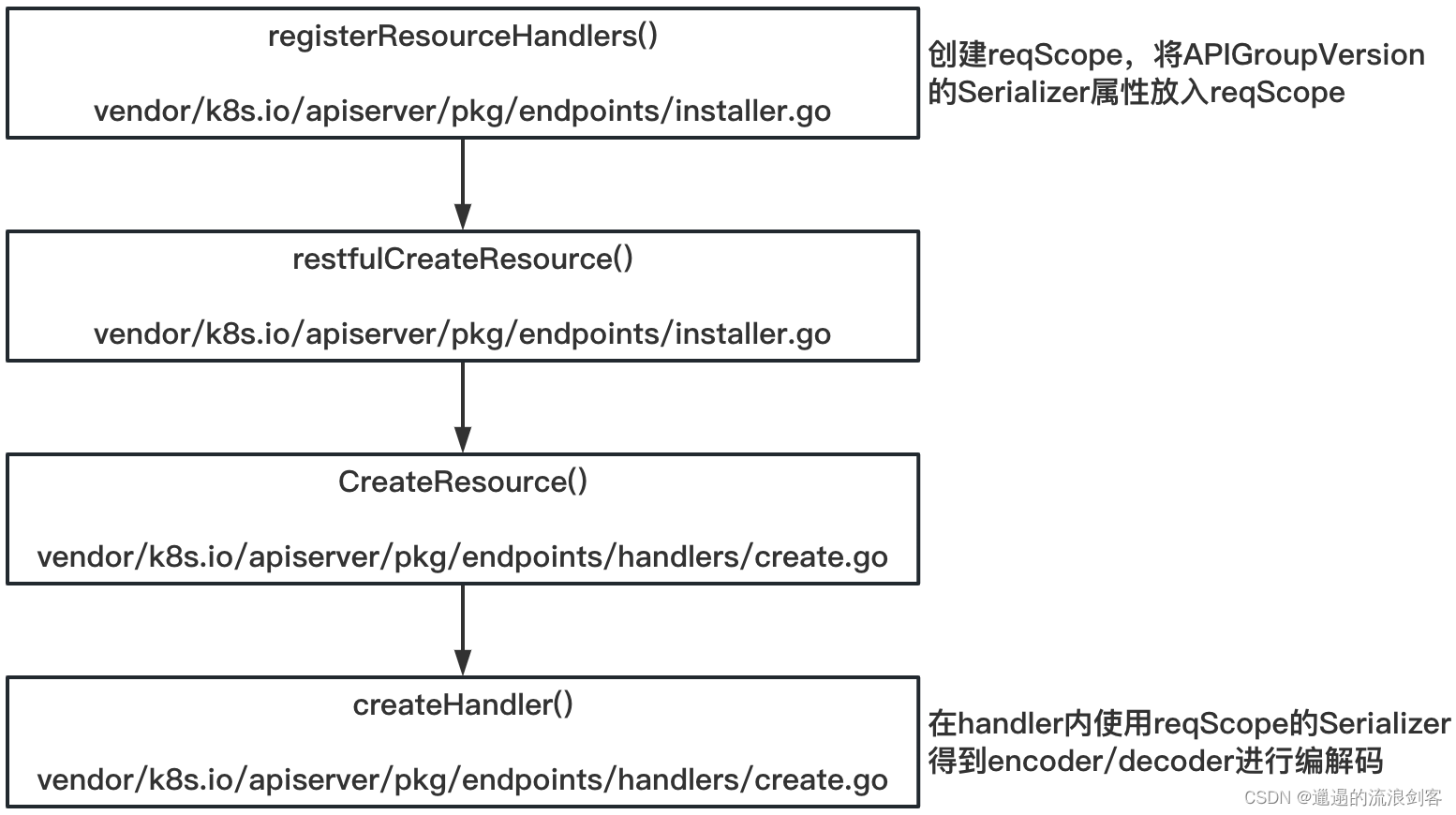
createHandler()The method code is as follows:
// vendor/k8s.io/apiserver/pkg/endpoints/handlers/create.go
func createHandler(r rest.NamedCreater, scope *RequestScope, admit admission.Interface, includeName bool) http.HandlerFunc {
return func(w http.ResponseWriter, req *http.Request) {
// For performance tracking purposes.
trace := utiltrace.New("Create", traceFields(req)...)
defer trace.LogIfLong(500 * time.Millisecond)
if isDryRun(req.URL) && !utilfeature.DefaultFeatureGate.Enabled(features.DryRun) {
scope.err(errors.NewBadRequest("the dryRun feature is disabled"), w, req)
return
}
namespace, name, err := scope.Namer.Name(req)
if err != nil {
if includeName {
// name was required, return
scope.err(err, w, req)
return
}
// otherwise attempt to look up the namespace
namespace, err = scope.Namer.Namespace(req)
if err != nil {
scope.err(err, w, req)
return
}
}
// enforce a timeout of at most requestTimeoutUpperBound (34s) or less if the user-provided
// timeout inside the parent context is lower than requestTimeoutUpperBound.
ctx, cancel := context.WithTimeout(req.Context(), requestTimeoutUpperBound)
defer cancel()
outputMediaType, _, err := negotiation.NegotiateOutputMediaType(req, scope.Serializer, scope)
if err != nil {
scope.err(err, w, req)
return
}
gv := scope.Kind.GroupVersion()
s, err := negotiation.NegotiateInputSerializer(req, false, scope.Serializer)
if err != nil {
scope.err(err, w, req)
return
}
decoder := scope.Serializer.DecoderToVersion(s.Serializer, scope.HubGroupVersion)
body, err := limitedReadBody(req, scope.MaxRequestBodyBytes)
if err != nil {
scope.err(err, w, req)
return
}
options := &metav1.CreateOptions{
}
values := req.URL.Query()
if err := metainternalversionscheme.ParameterCodec.DecodeParameters(values, scope.MetaGroupVersion, options); err != nil {
err = errors.NewBadRequest(err.Error())
scope.err(err, w, req)
return
}
if errs := validation.ValidateCreateOptions(options); len(errs) > 0 {
err := errors.NewInvalid(schema.GroupKind{
Group: metav1.GroupName, Kind: "CreateOptions"}, "", errs)
scope.err(err, w, req)
return
}
options.TypeMeta.SetGroupVersionKind(metav1.SchemeGroupVersion.WithKind("CreateOptions"))
defaultGVK := scope.Kind
original := r.New()
trace.Step("About to convert to expected version")
// 1)处理请求前,使用reqScope的Serializer得到decoder进行解码
obj, gvk, err := decoder.Decode(body, &defaultGVK, original)
if err != nil {
err = transformDecodeError(scope.Typer, err, original, gvk, body)
scope.err(err, w, req)
return
}
objGV := gvk.GroupVersion()
if !scope.AcceptsGroupVersion(objGV) {
err = errors.NewBadRequest(fmt.Sprintf("the API version in the data (%s) does not match the expected API version (%v)", objGV.String(), gv.String()))
scope.err(err, w, req)
return
}
trace.Step("Conversion done")
// On create, get name from new object if unset
if len(name) == 0 {
_, name, _ = scope.Namer.ObjectName(obj)
}
if len(namespace) == 0 && *gvk == namespaceGVK {
namespace = name
}
ctx = request.WithNamespace(ctx, namespace)
ae := request.AuditEventFrom(ctx)
admit = admission.WithAudit(admit, ae)
audit.LogRequestObject(ae, obj, objGV, scope.Resource, scope.Subresource, scope.Serializer)
userInfo, _ := request.UserFrom(ctx)
trace.Step("About to store object in database")
admissionAttributes := admission.NewAttributesRecord(obj, nil, scope.Kind, namespace, name, scope.Resource, scope.Subresource, admission.Create, options, dryrun.IsDryRun(options.DryRun), userInfo)
requestFunc := func() (runtime.Object, error) {
return r.Create(
ctx,
name,
obj,
rest.AdmissionToValidateObjectFunc(admit, admissionAttributes, scope),
options,
)
}
// Dedup owner references before updating managed fields
dedupOwnerReferencesAndAddWarning(obj, req.Context(), false)
result, err := finisher.FinishRequest(ctx, func() (runtime.Object, error) {
if scope.FieldManager != nil {
liveObj, err := scope.Creater.New(scope.Kind)
if err != nil {
return nil, fmt.Errorf("failed to create new object (Create for %v): %v", scope.Kind, err)
}
obj = scope.FieldManager.UpdateNoErrors(liveObj, obj, managerOrUserAgent(options.FieldManager, req.UserAgent()))
admit = fieldmanager.NewManagedFieldsValidatingAdmissionController(admit)
}
if mutatingAdmission, ok := admit.(admission.MutationInterface); ok && mutatingAdmission.Handles(admission.Create) {
if err := mutatingAdmission.Admit(ctx, admissionAttributes, scope); err != nil {
return nil, err
}
}
// Dedup owner references again after mutating admission happens
dedupOwnerReferencesAndAddWarning(obj, req.Context(), true)
result, err := requestFunc()
// If the object wasn't committed to storage because it's serialized size was too large,
// it is safe to remove managedFields (which can be large) and try again.
if isTooLargeError(err) {
if accessor, accessorErr := meta.Accessor(obj); accessorErr == nil {
accessor.SetManagedFields(nil)
result, err = requestFunc()
}
}
return result, err
})
if err != nil {
scope.err(err, w, req)
return
}
trace.Step("Object stored in database")
code := http.StatusCreated
status, ok := result.(*metav1.Status)
if ok && err == nil && status.Code == 0 {
status.Code = int32(code)
}
// 2)响应时,使用reqScope的Serializer得到encoder进行解码
transformResponseObject(ctx, scope, trace, req, w, code, outputMediaType, result)
}
}
3), Store: the business logic part that responds to the Request
Take the Deployment of APIGroup apps as an example:

Calling the method corresponding to Deployment returns DeploymentStorage. Finally, the method NewStorage()corresponding to Deployment is called . The code is as follows:NewREST()
// pkg/registry/apps/deployment/storage/storage.go
func NewStorage(optsGetter generic.RESTOptionsGetter) (DeploymentStorage, error) {
deploymentRest, deploymentStatusRest, deploymentRollbackRest, err := NewREST(optsGetter)
if err != nil {
return DeploymentStorage{
}, err
}
return DeploymentStorage{
Deployment: deploymentRest,
Status: deploymentStatusRest,
Scale: &ScaleREST{
store: deploymentRest.Store},
Rollback: deploymentRollbackRest,
}, nil
}
type REST struct {
*genericregistry.Store
categories []string
}
func NewREST(optsGetter generic.RESTOptionsGetter) (*REST, *StatusREST, *RollbackREST, error) {
store := &genericregistry.Store{
NewFunc: func() runtime.Object {
return &apps.Deployment{
} },
NewListFunc: func() runtime.Object {
return &apps.DeploymentList{
} },
DefaultQualifiedResource: apps.Resource("deployments"),
CreateStrategy: deployment.Strategy,
UpdateStrategy: deployment.Strategy,
DeleteStrategy: deployment.Strategy,
ResetFieldsStrategy: deployment.Strategy,
TableConvertor: printerstorage.TableConvertor{
TableGenerator: printers.NewTableGenerator().With(printersinternal.AddHandlers)},
}
options := &generic.StoreOptions{
RESTOptions: optsGetter}
if err := store.CompleteWithOptions(options); err != nil {
return nil, nil, nil, err
}
statusStore := *store
statusStore.UpdateStrategy = deployment.StatusStrategy
statusStore.ResetFieldsStrategy = deployment.StatusStrategy
return &REST{
store, []string{
"all"}}, &StatusREST{
store: &statusStore}, &RollbackREST{
store: store}, nil
}
NewREST()The method is used to construct and return REST structure instances, including sub-Objects.
Each APIObject will have a REST structure, which is responsible for the final processing of the Request for this Object; and this REST structure most often directly reuses its properties and methods by embedding the genericregistry.Store structure, especially the built-in APIObject, so This Store structure contains most of the processing logic. The REST structure is generally defined in the corresponding storage/storage.gofile of APIObject.
genericregistry.Store:
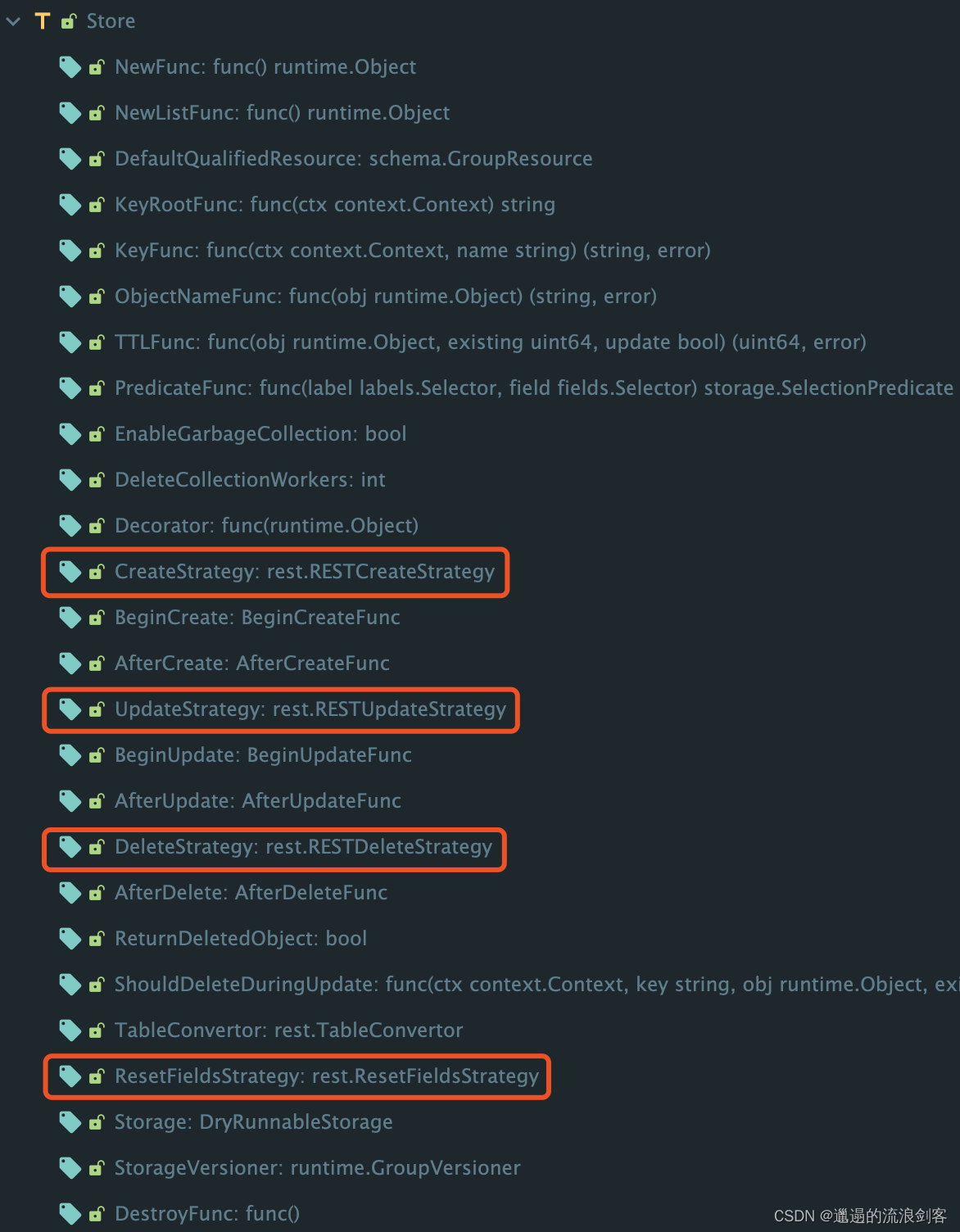
The required Strategy methods are defined in the properties of genericregistry.Store. They are extension points provided by GenericAPIServer to the outside. Each APIObject can write its own strategy to intervene in the process of creation, modification, deletion, etc.
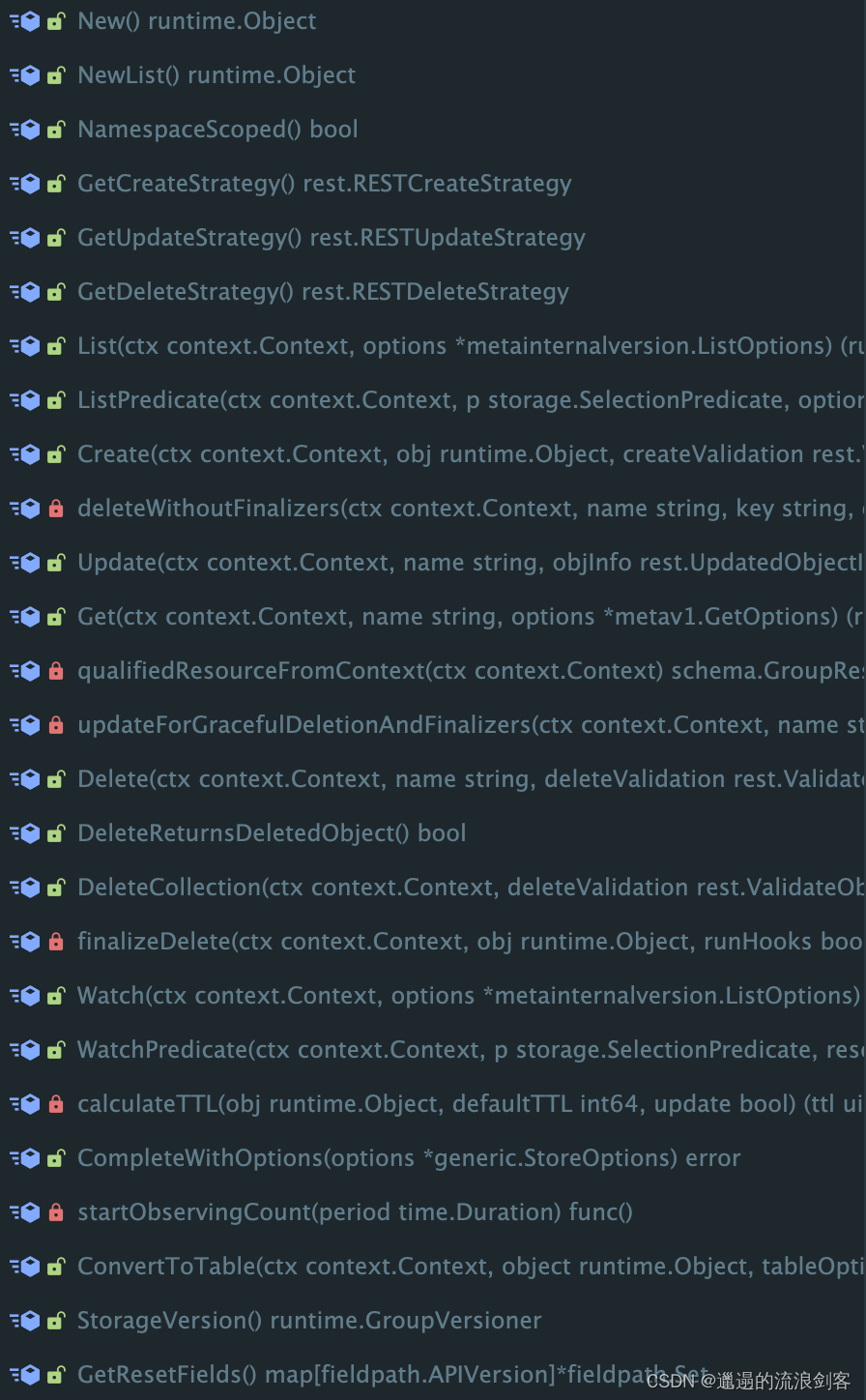
genericregistry.Store contains Get, Create, Update, Delete and other methods, which will eventually be called by RequestHandler to complete the request task. Most of the built-in APIObjects reuse Store, thus avoiding the need to write a lot of logic yourself and allowing the Strategy model to continue to be effective.
Taking Create as an example, the corresponding Strategy interface is as follows:
// vendor/k8s.io/apiserver/pkg/registry/rest/create.go
type RESTCreateStrategy interface {
runtime.ObjectTyper
// The name generator is used when the standard GenerateName field is set.
// The NameGenerator will be invoked prior to validation.
names.NameGenerator
// NamespaceScoped returns true if the object must be within a namespace.
NamespaceScoped() bool
// PrepareForCreate is invoked on create before validation to normalize
// the object. For example: remove fields that are not to be persisted,
// sort order-insensitive list fields, etc. This should not remove fields
// whose presence would be considered a validation error.
//
// Often implemented as a type check and an initailization or clearing of
// status. Clear the status because status changes are internal. External
// callers of an api (users) should not be setting an initial status on
// newly created objects.
PrepareForCreate(ctx context.Context, obj runtime.Object)
// Validate returns an ErrorList with validation errors or nil. Validate
// is invoked after default fields in the object have been filled in
// before the object is persisted. This method should not mutate the
// object.
Validate(ctx context.Context, obj runtime.Object) field.ErrorList
// WarningsOnCreate returns warnings to the client performing a create.
// WarningsOnCreate is invoked after default fields in the object have been filled in
// and after Validate has passed, before Canonicalize is called, and the object is persisted.
// This method must not mutate the object.
//
// Be brief; limit warnings to 120 characters if possible.
// Don't include a "Warning:" prefix in the message (that is added by clients on output).
// Warnings returned about a specific field should be formatted as "path.to.field: message".
// For example: `spec.imagePullSecrets[0].name: invalid empty name ""`
//
// Use warning messages to describe problems the client making the API request should correct or be aware of.
// For example:
// - use of deprecated fields/labels/annotations that will stop working in a future release
// - use of obsolete fields/labels/annotations that are non-functional
// - malformed or invalid specifications that prevent successful handling of the submitted object,
// but are not rejected by validation for compatibility reasons
//
// Warnings should not be returned for fields which cannot be resolved by the caller.
// For example, do not warn about spec fields in a subresource creation request.
WarningsOnCreate(ctx context.Context, obj runtime.Object) []string
// Canonicalize allows an object to be mutated into a canonical form. This
// ensures that code that operates on these objects can rely on the common
// form for things like comparison. Canonicalize is invoked after
// validation has succeeded but before the object has been persisted.
// This method may mutate the object. Often implemented as a type check or
// empty method.
Canonicalize(obj runtime.Object)
}
The logic related to Store in the API Resource loading process is as follows:

Through the previous analysis of Serializer and Admission, we know that Http requests are ultimately constructed in methods such as createHandler
For example, Create (HTTP POST) is vendor/k8s.io/apiserver/pkg/endpoints/handlers/create.goin the createHandler method in the file

And Update (HTTP PUT) is in vendor/k8s.io/apiserver/pkg/endpoints/handlers/update.gothe UpdateResource method in the file

The variable r in these two places is the formal parameter passed in, and its actual parameter is the above Store structure instance.
14、Authentication与Authorization
1), user types and user information
There are two categories of users:
- Service Account: In-cluster management, the main purpose is to connect the programs in the cluster to the APIServer
- Normal User: provided outside the cluster. It is more like an abstract concept for the cluster and is not responsible for preservation and maintenance.
Users contain the following information. The login process obtains this information and puts it into the Request, which is used in the authentication process:
- Name: username
- UID: Unique ID
- Groups: the group to which it belongs
- Extra fields: Some additional information, which differs due to different login verification strategies
2) Login verification strategy
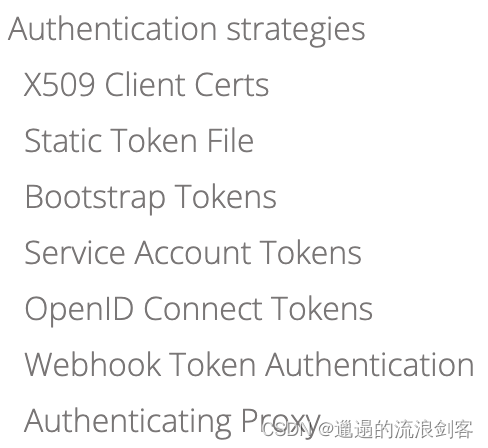
When an HTTP request comes, it must first go through the login process. One of the Server's Filters is responsible for login verification.
There are many strategies for login verification, as shown in the figure above. As long as a Request is explicitly approved or explicitly rejected by a policy, the login process is over.
The system has an Anonymous policy by default: If the above policies are neither Approve nor Reject, then the Request will be given the Anonymous identity and handed over to the Server for processing.
3), authentication mode
There are 4 authentication modes in Kubernetes:
- Role Based Access Control (RBAC): The current default authentication mode is to define Role/ClusterRole and then use RoleBinding/ClusterRoleBinding to assign them to user or group
- Attribute Based Access Control (ABAC): Determine whether a Request can do something based on various attributes (user, group, target resource, and even environment variables)
- Node Authorization: Mainly authenticates requests from kuberlet
- Webhook Authorization: APIServer hands over the authentication work to a web service. The server sends a SubjectAccessReview object to the service. The service makes a judgment and attaches the result to the SAR and uploads it back.
4) When does Authentication & Authorization occur?

When an HTTP request comes in, it first enters AggregatorServer. AggregatorServer will perform login verification and authentication.
- If the request is processed by KubeAPIServer or APIExtensionsServer, the request will be distributed through delegation, and login and authentication verification will not be performed on KubeAPIServer and APIExtensionsServer.
- If the request is processed by CustomServer and the request is forwarded through Proxy, CustomServer will verify the certificate information attached to the HTTP Request forwarded by Proxy to confirm whether it was forwarded by AggregatorServer. At this time, the Request will contain user login information, and CustomServer will not proceed any further. Login authentication. But it will be authenticated. CustomServer will send a SubjectAccessReview Request to AggregatorServer for verification. AggregatorServer will attach the verification result to SubjectAccessReview and send it back to CustomServer.

After a Request enters AggregatorServer, it will first go through Filter login and authentication.
1) Trigger login and authentication path 1: Delegate mechanism
vendor/k8s.io/apiserver/pkg/server/config.goNew method in file

Question: On the Delegate path, in addition to happening once on AggregatorServer, will login and authentication happen on KubeAPIServer and APIExtensionsServer?
Answer : No, this is obviously redundant verification. When forming a delegation chain (Server Chain), the unprotectedHandler of the next Server is used. It is not wrapped by Filter and will naturally not trigger login and authentication (code 1).
2) Trigger login and authentication path 2: Proxy mechanism
vendor/k8s.io/kube-aggregator/pkg/apiserver/apiserver.goAddAPIService method in file

Question: Why does login and authentication occur on the Proxy path?
Answer : The code in the above picture is to assign an Http handler to the APIGroup represented by an APIService object in the AggregatorServer. You can see that it is still handed over to GenericAPIServer's NonGoRestfulMux. Then after each Request arrives, the Filter Chain will be executed, thereby triggering the login and authentication (see the preface chapter to explain the formation of the Server Chain. This NonGoRestfulMux is actually in the director Behind the scenes, it accepts requests transferred from the director, and the director is packaged by Filter)
5) Implementation and loading of login validator
// pkg/kubeapiserver/authenticator/config.go
func (config Config) New() (authenticator.Request, *spec.SecurityDefinitions, error) {
var authenticators []authenticator.Request
var tokenAuthenticators []authenticator.Token
securityDefinitions := spec.SecurityDefinitions{
}
// front-proxy, BasicAuth methods, local first, then remote
// Add the front proxy authenticator if requested
// Authenticating Proxy策略
if config.RequestHeaderConfig != nil {
requestHeaderAuthenticator := headerrequest.NewDynamicVerifyOptionsSecure(
config.RequestHeaderConfig.CAContentProvider.VerifyOptions,
config.RequestHeaderConfig.AllowedClientNames,
config.RequestHeaderConfig.UsernameHeaders,
config.RequestHeaderConfig.GroupHeaders,
config.RequestHeaderConfig.ExtraHeaderPrefixes,
)
authenticators = append(authenticators, authenticator.WrapAudienceAgnosticRequest(config.APIAudiences, requestHeaderAuthenticator))
}
// X509 methods
// X509 Client Certs策略
if config.ClientCAContentProvider != nil {
certAuth := x509.NewDynamic(config.ClientCAContentProvider.VerifyOptions, x509.CommonNameUserConversion)
authenticators = append(authenticators, certAuth)
}
// Bearer token methods, local first, then remote
// Static Token File策略
if len(config.TokenAuthFile) > 0 {
tokenAuth, err := newAuthenticatorFromTokenFile(config.TokenAuthFile)
if err != nil {
return nil, nil, err
}
tokenAuthenticators = append(tokenAuthenticators, authenticator.WrapAudienceAgnosticToken(config.APIAudiences, tokenAuth))
}
// Service Account Tokens策略
if len(config.ServiceAccountKeyFiles) > 0 {
serviceAccountAuth, err := newLegacyServiceAccountAuthenticator(config.ServiceAccountKeyFiles, config.ServiceAccountLookup, config.APIAudiences, config.ServiceAccountTokenGetter)
if err != nil {
return nil, nil, err
}
tokenAuthenticators = append(tokenAuthenticators, serviceAccountAuth)
}
if len(config.ServiceAccountIssuers) > 0 {
serviceAccountAuth, err := newServiceAccountAuthenticator(config.ServiceAccountIssuers, config.ServiceAccountKeyFiles, config.APIAudiences, config.ServiceAccountTokenGetter)
if err != nil {
return nil, nil, err
}
tokenAuthenticators = append(tokenAuthenticators, serviceAccountAuth)
}
// Bootstrap Tokens策略
if config.BootstrapToken {
if config.BootstrapTokenAuthenticator != nil {
// TODO: This can sometimes be nil because of
tokenAuthenticators = append(tokenAuthenticators, authenticator.WrapAudienceAgnosticToken(config.APIAudiences, config.BootstrapTokenAuthenticator))
}
}
// NOTE(ericchiang): Keep the OpenID Connect after Service Accounts.
//
// Because both plugins verify JWTs whichever comes first in the union experiences
// cache misses for all requests using the other. While the service account plugin
// simply returns an error, the OpenID Connect plugin may query the provider to
// update the keys, causing performance hits.
// OpenID Connect Tokens策略
if len(config.OIDCIssuerURL) > 0 && len(config.OIDCClientID) > 0 {
// TODO(enj): wire up the Notifier and ControllerRunner bits when OIDC supports CA reload
var oidcCAContent oidc.CAContentProvider
if len(config.OIDCCAFile) != 0 {
var oidcCAErr error
oidcCAContent, oidcCAErr = dynamiccertificates.NewDynamicCAContentFromFile("oidc-authenticator", config.OIDCCAFile)
if oidcCAErr != nil {
return nil, nil, oidcCAErr
}
}
oidcAuth, err := newAuthenticatorFromOIDCIssuerURL(oidc.Options{
IssuerURL: config.OIDCIssuerURL,
ClientID: config.OIDCClientID,
CAContentProvider: oidcCAContent,
UsernameClaim: config.OIDCUsernameClaim,
UsernamePrefix: config.OIDCUsernamePrefix,
GroupsClaim: config.OIDCGroupsClaim,
GroupsPrefix: config.OIDCGroupsPrefix,
SupportedSigningAlgs: config.OIDCSigningAlgs,
RequiredClaims: config.OIDCRequiredClaims,
})
if err != nil {
return nil, nil, err
}
tokenAuthenticators = append(tokenAuthenticators, authenticator.WrapAudienceAgnosticToken(config.APIAudiences, oidcAuth))
}
// Webhook Token Authentication策略
if len(config.WebhookTokenAuthnConfigFile) > 0 {
webhookTokenAuth, err := newWebhookTokenAuthenticator(config)
if err != nil {
return nil, nil, err
}
tokenAuthenticators = append(tokenAuthenticators, webhookTokenAuth)
}
if len(tokenAuthenticators) > 0 {
// Union the token authenticators
tokenAuth := tokenunion.New(tokenAuthenticators...)
// Optionally cache authentication results
if config.TokenSuccessCacheTTL > 0 || config.TokenFailureCacheTTL > 0 {
tokenAuth = tokencache.New(tokenAuth, true, config.TokenSuccessCacheTTL, config.TokenFailureCacheTTL)
}
authenticators = append(authenticators, bearertoken.New(tokenAuth), websocket.NewProtocolAuthenticator(tokenAuth))
securityDefinitions["BearerToken"] = &spec.SecurityScheme{
SecuritySchemeProps: spec.SecuritySchemeProps{
Type: "apiKey",
Name: "authorization",
In: "header",
Description: "Bearer Token authentication",
},
}
}
if len(authenticators) == 0 {
if config.Anonymous {
return anonymous.NewAuthenticator(), &securityDefinitions, nil
}
return nil, &securityDefinitions, nil
}
authenticator := union.New(authenticators...)
authenticator = group.NewAuthenticatedGroupAdder(authenticator)
// Anonymous策略
if config.Anonymous {
// If the authenticator chain returns an error, return an error (don't consider a bad bearer token
// or invalid username/password combination anonymous).
authenticator = union.NewFailOnError(authenticator, anonymous.NewAuthenticator())
}
return authenticator, &securityDefinitions, nil
}
6) Implementation and loading of authenticator
// pkg/kubeapiserver/authorizer/config.go
func (config Config) New() (authorizer.Authorizer, authorizer.RuleResolver, error) {
if len(config.AuthorizationModes) == 0 {
return nil, nil, fmt.Errorf("at least one authorization mode must be passed")
}
var (
authorizers []authorizer.Authorizer
ruleResolvers []authorizer.RuleResolver
)
for _, authorizationMode := range config.AuthorizationModes {
// Keep cases in sync with constant list in k8s.io/kubernetes/pkg/kubeapiserver/authorizer/modes/modes.go.
switch authorizationMode {
// Node Authorization
case modes.ModeNode:
node.RegisterMetrics()
graph := node.NewGraph()
node.AddGraphEventHandlers(
graph,
config.VersionedInformerFactory.Core().V1().Nodes(),
config.VersionedInformerFactory.Core().V1().Pods(),
config.VersionedInformerFactory.Core().V1().PersistentVolumes(),
config.VersionedInformerFactory.Storage().V1().VolumeAttachments(),
)
nodeAuthorizer := node.NewAuthorizer(graph, nodeidentifier.NewDefaultNodeIdentifier(), bootstrappolicy.NodeRules())
authorizers = append(authorizers, nodeAuthorizer)
ruleResolvers = append(ruleResolvers, nodeAuthorizer)
case modes.ModeAlwaysAllow:
alwaysAllowAuthorizer := authorizerfactory.NewAlwaysAllowAuthorizer()
authorizers = append(authorizers, alwaysAllowAuthorizer)
ruleResolvers = append(ruleResolvers, alwaysAllowAuthorizer)
case modes.ModeAlwaysDeny:
alwaysDenyAuthorizer := authorizerfactory.NewAlwaysDenyAuthorizer()
authorizers = append(authorizers, alwaysDenyAuthorizer)
ruleResolvers = append(ruleResolvers, alwaysDenyAuthorizer)
// ABAC
case modes.ModeABAC:
abacAuthorizer, err := abac.NewFromFile(config.PolicyFile)
if err != nil {
return nil, nil, err
}
authorizers = append(authorizers, abacAuthorizer)
ruleResolvers = append(ruleResolvers, abacAuthorizer)
// Webhook Authorization
case modes.ModeWebhook:
if config.WebhookRetryBackoff == nil {
return nil, nil, errors.New("retry backoff parameters for authorization webhook has not been specified")
}
webhookAuthorizer, err := webhook.New(config.WebhookConfigFile,
config.WebhookVersion,
config.WebhookCacheAuthorizedTTL,
config.WebhookCacheUnauthorizedTTL,
*config.WebhookRetryBackoff,
config.CustomDial)
if err != nil {
return nil, nil, err
}
authorizers = append(authorizers, webhookAuthorizer)
ruleResolvers = append(ruleResolvers, webhookAuthorizer)
// RBAC
case modes.ModeRBAC:
rbacAuthorizer := rbac.New(
&rbac.RoleGetter{
Lister: config.VersionedInformerFactory.Rbac().V1().Roles().Lister()},
&rbac.RoleBindingLister{
Lister: config.VersionedInformerFactory.Rbac().V1().RoleBindings().Lister()},
&rbac.ClusterRoleGetter{
Lister: config.VersionedInformerFactory.Rbac().V1().ClusterRoles().Lister()},
&rbac.ClusterRoleBindingLister{
Lister: config.VersionedInformerFactory.Rbac().V1().ClusterRoleBindings().Lister()},
)
authorizers = append(authorizers, rbacAuthorizer)
ruleResolvers = append(ruleResolvers, rbacAuthorizer)
default:
return nil, nil, fmt.Errorf("unknown authorization mode %s specified", authorizationMode)
}
}
return union.New(authorizers...), union.NewRuleResolvers(ruleResolvers...), nil
}
reference:
Kubernetes source code development journey three: API Server source code analysis